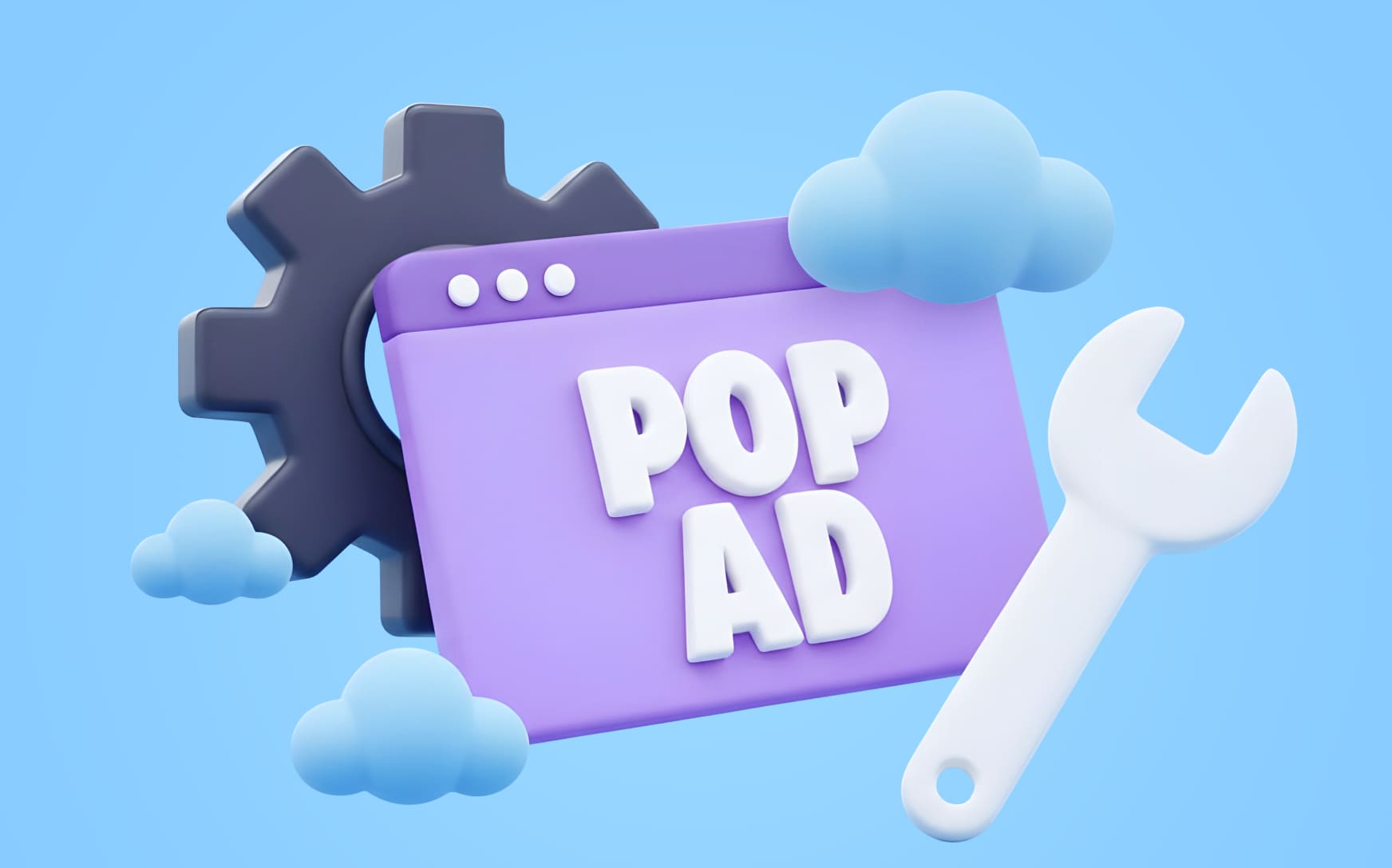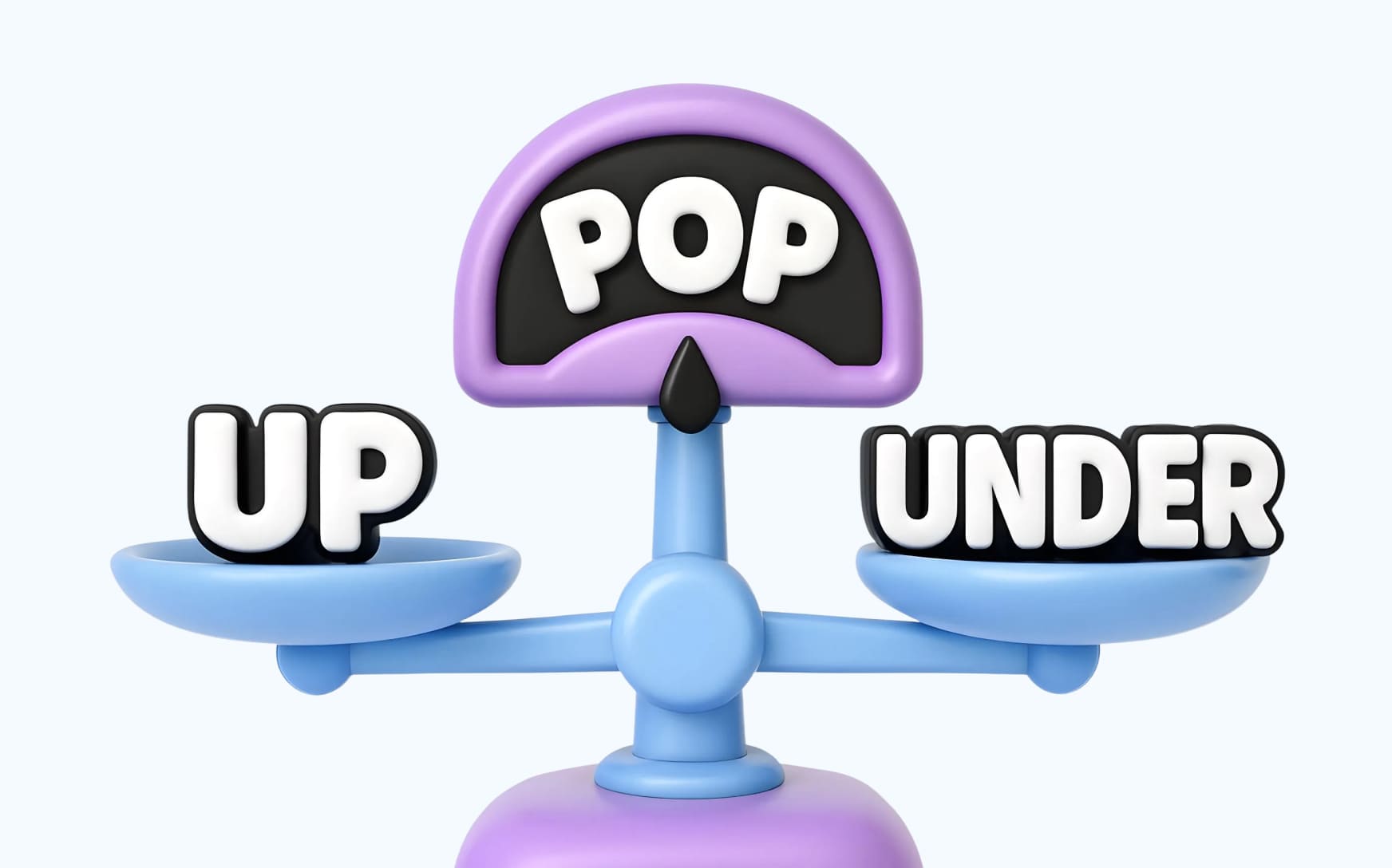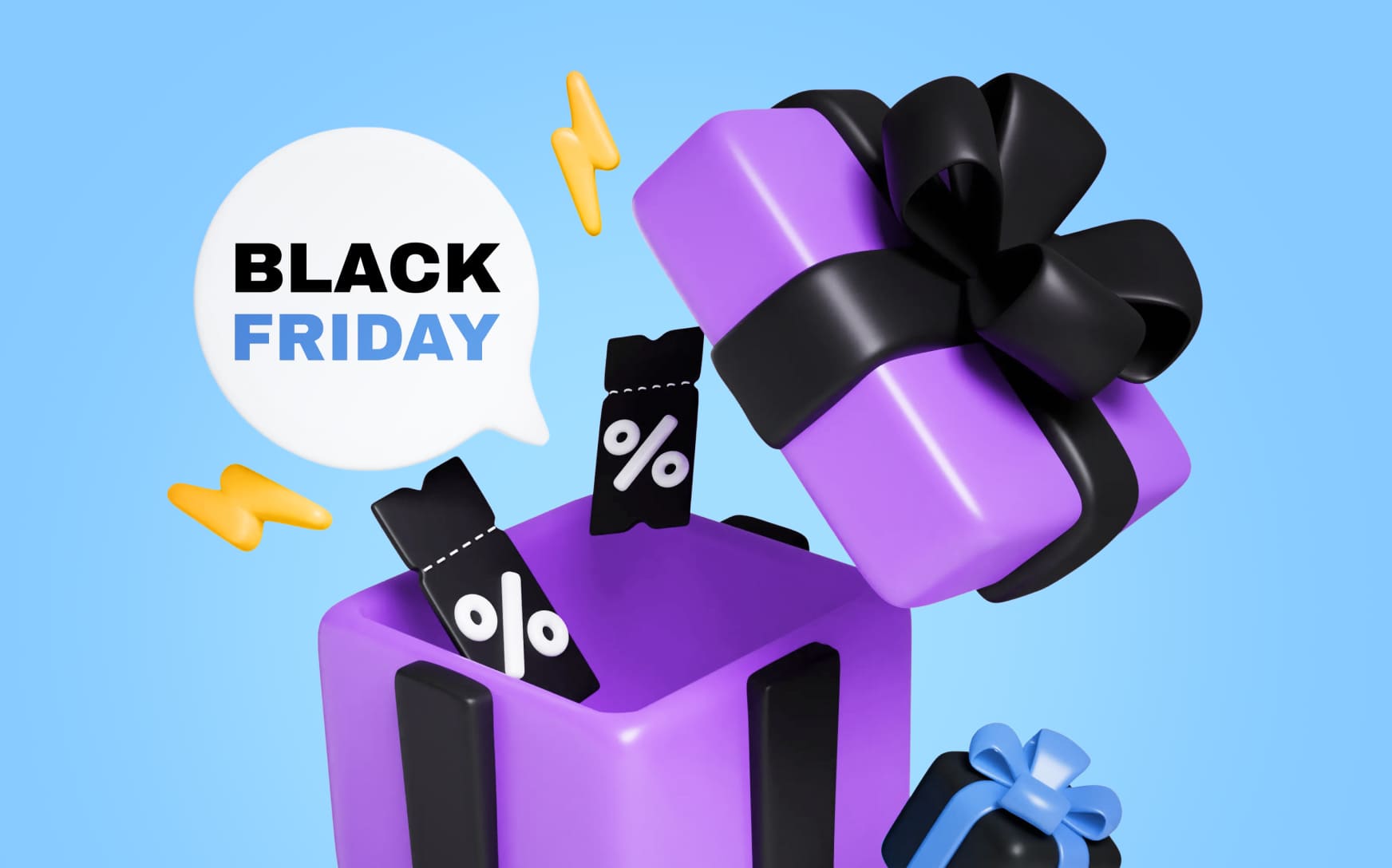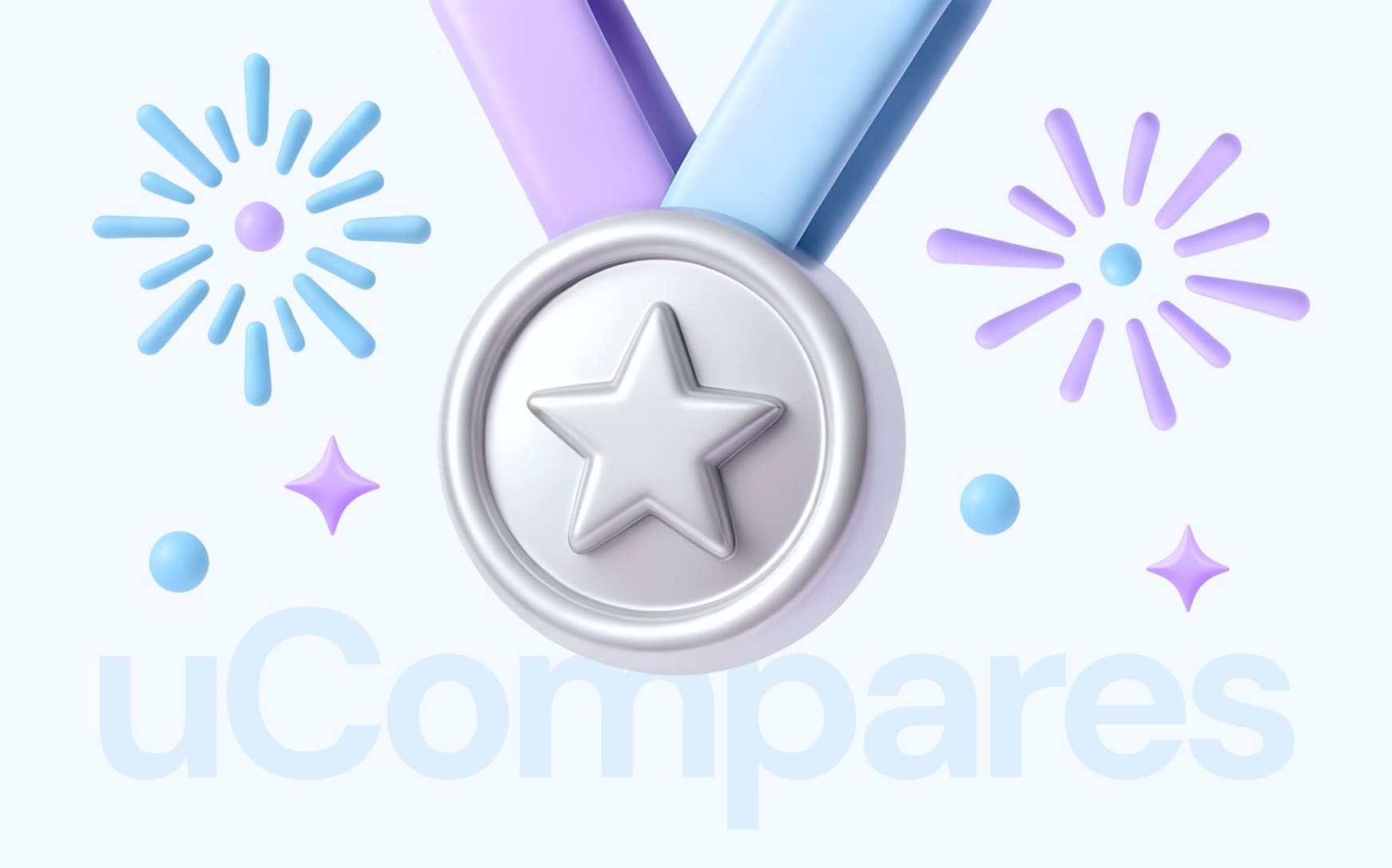To set up a pop campaign you create an account in the ad network, choose the pop format, add your landing page URL and configure postback tracking. Then define targeting, set a budget and CPM bid, schedule delivery and adjust frequency. With tools like CPA Goal, AI bidding and Microbidding, affiliates can optimize traffic, scale conversions and maximize ROI.
Pop advertising has been around for years and even in 2025 it’s one of the most effective ways to drive large volumes of traffic at affordable rates. Unlike more restrictive formats, popups guarantee visibility: every impression gets delivered and every click comes from a real user who just engaged with your content in any vertical.
For affiliate marketers and media buyers this makes pop marketing a practical entry point into performance advertising. Whether you’re testing new offers or scaling proven funnels, a well-structured setup can generate thousands of clicks daily and turn them into consistent profit.
At ROIads ad network, we’ve built our platform with this in mind. The network provides premium placements across 150+ geos, transparent statistics and smart automation tools like AI bidding technology and CPA Goal. Combined with source-level adjustments through Micro bidding, these features help advertisers cut through the guesswork and focus on growing ROI.

In this guide, you’ll learn how to:
- Create and launch a pop ads campaign step by step
- Understand the key elements that affect impressions, clicks and conversions
- Use targeting, bidding and budget strategies effectively
- Optimize funnels for long-term results
Later in the article, we’ll walk through the exact process of campaign setup. Until then let’s start with why affiliates still choose pop advertising in 2025.
What Are Pop Ads (Popups & Popunders)?
Pop advertising usually refers to two main groups of formats.
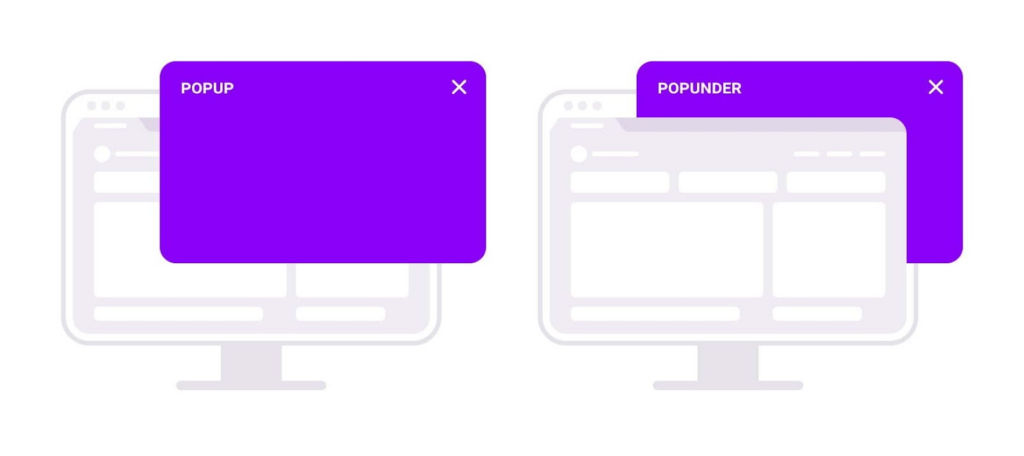
1. Popups
Popup ads open in a new window directly above the content the user is viewing. Because they are instantly visible, they can drive strong engagement and ROI. However, they’re also more intrusive and many users close them immediately.
2. Popunders (including Clickunders)
Popunder ads open in a new browser window or tab behind the current one. Popunders appear after the main page is closed, clickunders trigger when a user clicks anywhere on the site. Both are less intrusive than popups so users are more likely to engage with the offer calmly.
Why Run Advertising Campaigns with Pop Traffic in 2025
Pop advertising is one of the most reliable formats for affiliates in 2025. With guaranteed impressions, competitive pricing and massive reach, it gives media buyers a direct way to test offers and scale traffic across geos.
Fresh Statistics
- According to Hostinger, the global affiliate marketing industry was valued at $18.5 billion in 2024 and is expected to reach $31.7 billion by 2031.
- More than 80% of brands already run affiliate programs, many of them powered by pop traffic and other performance channels.
- According to DemandSage, around 16% of all U.S. online purchases are driven by affiliate channels.
These numbers prove that the demand for performance-driven traffic keeps growing and pop formats stay relevant for affiliates looking for volume and conversions.
Key Benefits of Popup & Popunder Ads Marketing
- Massive traffic at scale
Popups generate millions of impressions per day, so you can reach wide audiences instantly. - Affordable pricing models
CPM and CPA rates for pop ads are usually lower than other digital formats, so it’s perfect for testing offers. - Fast testing and scaling
Pop traffic lets you quickly identify converting sources and optimize placements to maximize ROI. - Flexible funnel strategies
Strong pre-landing/landing pages allow for rapid funnel testing and higher conversion rates.
⚠️ When Pop Advertising May Not Fit
- If your offer requires long decision-making (B2B or high-ticket products).
- If your landing page is slow or unoptimized — you’ll lose clicks and waste budget.
- If you skip proper tracking, so you can’t evaluate which placements bring conversions.
Why Choose ROIads for Pop Advertising
Before we get into the step-by-step pop traffic setup guide, let’s take a quick look at ROIads ad network — top pop traffic source.
ROIads is a global network built by performance marketers for performance marketers. The platform focuses on two of the most effective formats for affiliates, push and pop advertising, and delivers:
- Massive scale: over 900M daily impressions across 150+ geos
- Smart automation: CPA Goal, AI bidding technology, and Micro bidding for streamlined optimization
- Transparent traffic: full placement reporting with the ability to blacklist or whitelist sources
- Personal support: dedicated managers for advertisers depositing $500+
- Seamless integrations: ready-to-use postback connections with top trackers
This is why ROIads is a great choice for affiliates who want to test offers quickly, gather clean data, and scale campaigns with precision.
Now, let’s break down exactly how to set up a pop campaign in ROIads from start to finish.
Preparing Before You Setup a Pop Campaign
Jumping straight into campaign setup without preparation will result in wasted budget. A clear plan ensures your successful pop ads will generate not only clicks but conversions.
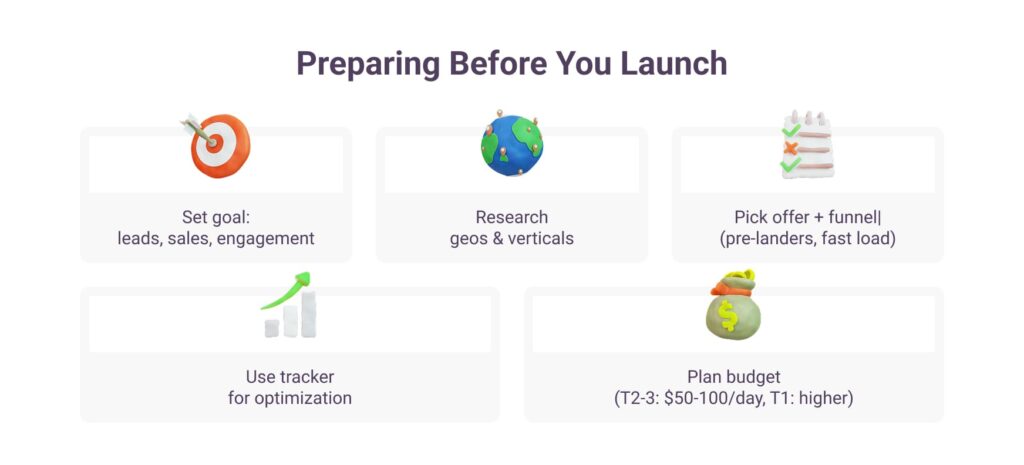
1. Define Your Goal
Decide what you want to achieve before you create a popunder campaign:
- Leads or sign-ups (email submit, registration, app install)
- Sales (direct purchases, trial activations)
- Engagement (traffic to a funnel, retargeting pool growth)
Each objective requires a slightly different funnel and landing page approach.
2. Research Geos and Verticals
Not all markets respond the same to pop traffic. Gambling, betting, utilities, antivirus and dating are among the top verticals for affiliates. Always check average CPM or CPA rates and conversion benchmarks in your target geo.
3. Choose the Right Offer and Funnel
- Align the offer payout with the cost of pop advertising in your chosen market.
- Prepare pre-landings to filter out unmotivated users before sending them to the final landing page.
- Make sure your funnel loads fast — every extra second increases bounce rates.
4. Get Postback Tracking in Place
A tracker is a must have to measure impressions, clicks and conversions across placements. Without postback tracking, you won’t know which sources are profitable or where to optimize.
5. Budget Planning
Start with a testing budget big enough to collect statistically relevant data. For Tier 2-3 geos, $50-$100 per day can be enough to test; for Tier 1 you’ll likely need more to compete.

Roya, Emotional Damage Officer & Supreme AI Arbitragist at ROIads
How to Set Up a Pop Ads Campaign in ROIads: Step-by-step Guide
If you’re wondering how to set up a pop campaign that really works, this step-by-step guide will help. The process covers everything from tracking and targeting to bidding and optimization — so your pop advertising runs smooth and profitable.
Step 1: Create an Account and Select Pop Format
Sign up with ROIads. Once registered, choose the pop ad format for your new campaign. This will make sure you’re driving traffic through popups and popunders, which have high visibility and massive reach.
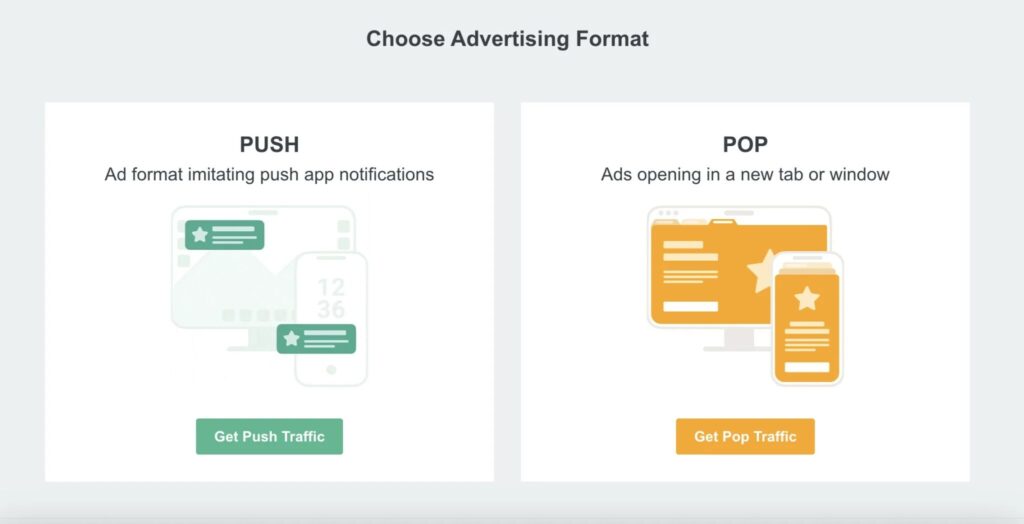
Step 2: Name the Campaign and Add a Landing Page URL
Assign a clear, unique name to your campaign for easy identification. Then, add the URL of the landing page or pre-landing page where traffic will be directed.
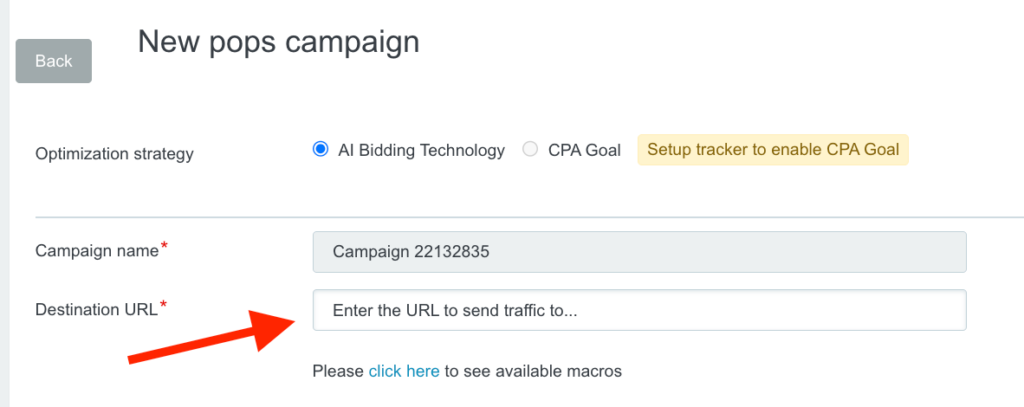
Step 3: Set Up Postback Tracking
To track conversions correctly, set up postback tracking. Select “Postback request” and enter the postback URL.

ROIads has seamless integrations with top trackers like Keitaro, RedTrack, BeMob, CPV Lab Pro, and PeerClick. These tools give you more insights to optimize your pop ads campaign setup.
For step-by-step instructions, check out our postback tracking guides. We have tutorials for each tracker we’re integrated with. For example, you can find there:
Step 4: Define Audience and Campaign Targeting
Targeting is key to controlling traffic and getting results. Start broad (entire country) and narrow down based on performance data.

Focus on:
- Geo targeting at country, region or city level
- Audience segments that click and convert
- Running separate campaigns for different geos to simplify optimization
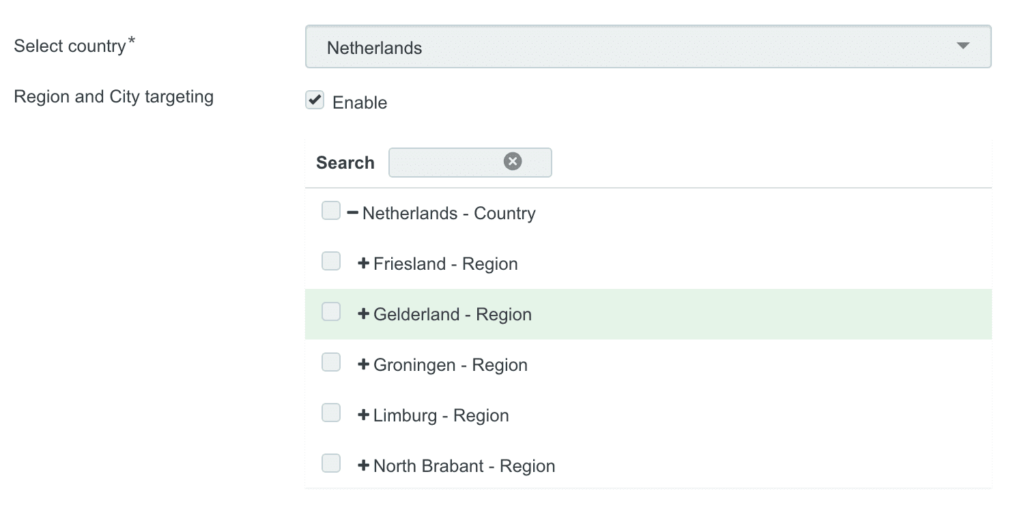
Step 5: Set Budget and CPM Bid
Next, configure the budget and bidding strategy. We recommend a starting CPM rate based on geo benchmarks, but you can adjust with your account manager. Also, you can find all costs in each geo in the Insight Tab in ROIads’ personal account. It’s avaliable for free to all users after registration.
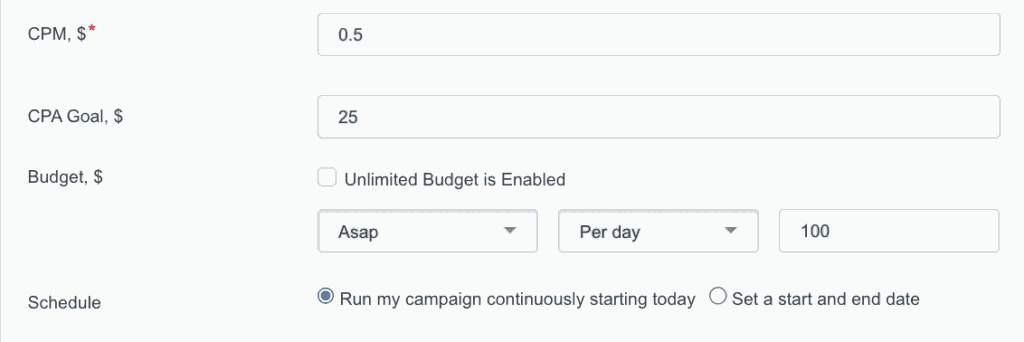
- Minimum CPM: $0.5
- CPA Goal: Helps filter unprofitable placements automatically once a valid postback is active
- Budget: Start with at least $25 daily and select “ASAP” delivery for faster data collection
This approach ensures you’re balancing spend and testing efficiency.
What to Choose: CPA Goal vs AI Bidding and Micro Bidding
To get the most out of ROIads’ automation, it’s important to understand how the tools differ:
| Feature | CPA Goal | AI Bidding Technology |
| Optimization Focus | Cost per acquisition (CPA) | Click-through rate + engagement |
| Based on | Conversion data | Behavioral data (CTR, activity) |
| Goal | Achieve stable CPA | Drive traffic to test offers/creatives |
| Best for | Scaling proven-converting offers | Testing new offers or creatives |
| Together? | ❌ No — choose one per campaign | |
- CPA Goal works best when you already have a converting offer. It automatically allocates traffic to sources delivering results at or below your target CPA.
- AI bidding technology is for early-stage campaigns when you need data and want to buy more clicks to test angles or creatives.

👉 Important: You can’t combine CPA Goal and AI bidding technology in the same campaign. Choose one depending on whether you’re scaling or testing.
CPA Goal + Micro Bidding
Unlike AI Bidding, Micro bidding can be combined with CPA Goal. This hybrid strategy allows you to:
- Manually adjust bids for specific zones or publishers
- React quickly to traffic behavior not yet captured by the algorithm
- Fine-tune high-performing placements while cutting weak ones
This is useful if:
- You want automation from CPA Goal but still need manual input
- You already know which geos or sources perform well and want tighter control
By combining CPA Goal with Micro bidding, affiliates can scale efficiently while keeping the flexibility to squeeze more profit from proven traffic segments.
Step 6: Schedule the Campaign
Timing matters in pop marketing. Use the scheduling feature to run ads during peak activity hours or specific events. For instance, targeting sports fans during matches often boosts engagement.

Be careful not to over-limit exposure; too narrow a schedule may restrict impressions and hurt campaign growth.
Step 7: Control Visit Frequency
Frequency settings determine how often the same user sees your popup. Configure them wisely to avoid ad fatigue while still maintaining exposure. Customize the frequency to allow visits per user over different time frames, such as 1 day, 7 days, or even longer periods like 30, 60, and 90 days.

ROIads account managers can recommend the best balance depending on your funnel and vertical.
Step 8: Configure Technology Targeting
Enable technology filters to fine tune campaign delivery. You can target by:
- Device (desktop vs. mobile)
- Operating system
- Browser type
- Connection type (WiFi, 3G/4G/5G)
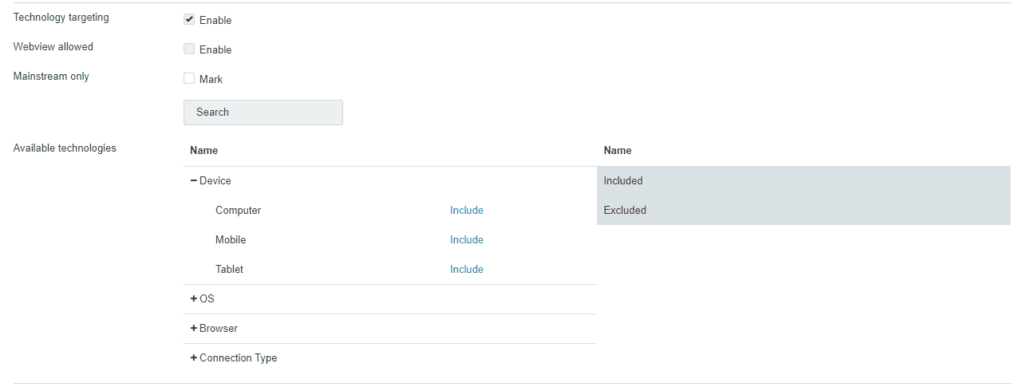
Running separate campaigns per device type allows for more precise bidding and easier performance tracking.
Step 9: Leverage Advanced Settings
Advanced controls allow you to push campaign performance further:
- Carrier and browser language targeting
- Custom timetables
- Whitelists and blacklists for placements and IPs
- Micro bidding to adjust bids for specific traffic segments

These tools give you granular control over placements and help scale a successful pop campaign more effectively.
By following these steps, you’ll be able to launch a pop ads campaign inside ROIads with confidence — from initial setup to advanced optimization.
Optimization and Scaling a Pop Campaign
Launching is only the beginning. To run a pop ads campaign profitably you need to constantly refine targeting and placements. Proper optimization ensures clicks turn into conversions and budget is allocated to the sources that deliver the best ROI.
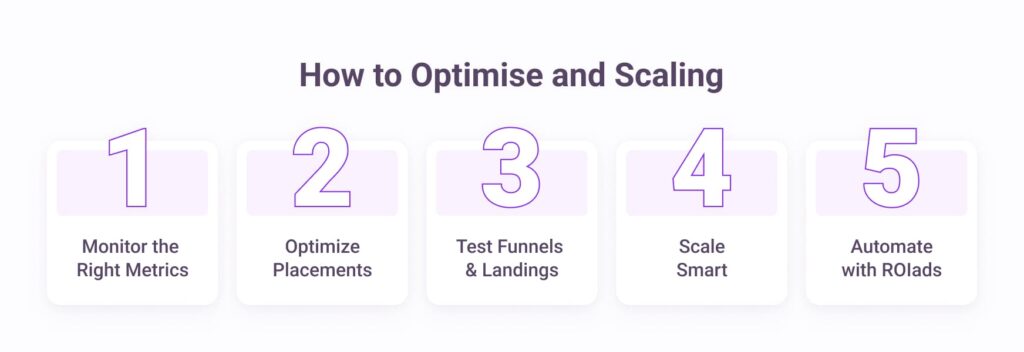
1. Monitor the Right Metrics
Track performance across the entire funnel:
- Impressions → Are you buying enough volume to collect data?
- Clicks → Is the CTR high enough to justify the spend?
- Conversions → Are you hitting the target CPA or overspending?
- EPC (Earnings per Click) → Does revenue cover the effective cost of traffic?
Using both your tracker and ROIads’ built-in statistics helps you see where traffic is profitable and where it needs adjustments.
2. Optimize Placements
Not all zones perform equally.
- Blacklist underperforming placements with poor CTR or no conversions.
- Whitelist profitable placements and increase volume there.
- Combine this with Micro bidding to raise or lower bids on individual publishers instead of cutting them entirely.
3. Test Funnels & Landing Pages
Since the landing page is where conversions happen, test it as much as you test traffic sources:
- Rotate several pre-landers to see which filters best
- A/B test headlines, CTAs and form lengths
- Ensure mobile load speed is optimized (most pop traffic is mobile)
Even small improvements in landing page CTR or conversion rate can drastically improve profitability.
4. Scale Smart
Once you have a working pop campaign, scaling is the next step:
- Vertical scaling: Increase budget and expand impressions on proven placements.
- Horizontal scaling: Replicate the campaign in new geos or with new offers in the same vertical.
- Device scaling: Split campaigns by device (desktop vs. mobile) to apply different bids.
5. Automate with ROIads
- CPA Goal ensures your campaign stays profitable by filtering out traffic above your target CPA.
- AI bidding technology is best during testing phases to drive volume and gather engagement data.
- Micro bidding allows manual fine-tuning when scaling, so you can squeeze extra profit from known-performing sources.It depends on the campaign stage: test with AI Bidding, switch to CPA Goal for scaling and add Micro bidding for fine-tuning.
Pro Tips & Best Practices for Consistent Optimization
- Don’t over-segment too early — broad targeting collects data faster.
- Watch frequency capping; too many impressions per user kill CTR.
- Keep testing new creatives and landings even in a stable campaign.
- Reinvest profits into higher-performing placements rather than chasing volume everywhere.
With optimization, a pop ads campaign goes from testing to profitability.
Optimization Checklist for Pop Ads Campaigns
| Frequency | Tasks |
| Daily | Compare spend vs. revenue Pause draining placements Adjust bids on active zones Monitor landing page load speed & CTR |
| Weekly | Refresh whitelists/blacklists Test new creatives and pre-landers Rebalance budget between devices/geos Review tracker stats for anomalies |
| Monthly | Evaluate ROI per source Adjust frequency caps & schedules Scale winners into new geos or verticals Audit funnel for outdated elements |
Learn from Real Campaigns
We’ve published multiple case studies showing how affiliates use ROIads pop traffic to get results. Check out these examples to see how it works, then apply the same to your funnel. You can repeat our advertisers success — or build your own winning campaign with us from scratch.
Mistakes to Avoid in Pop Campaigns
Even a good pop traffic campaign can fail if you miss the basics. Here are the most common:
- Underbidding — bidding too low means no traffic or low quality impressions.
- No pre-landings — sending users straight to the offer lowers conversion rates.
- Over-segmenting — segmenting too early limits data and blocks optimization.
- No tracking — no tracker and postback means no ROI or scaling.
Avoid these and affiliates will collect cleaner data and scale campaigns profitable.
FAQ: Step-by-step Guide to Setting Successful Popup & Popunder Campaign
❓What is a pop campaign?
A pop campaign is a digital advertising campaign that uses pop traffic (popups and popunders) as its traffic source. It’s not a format itself, but a way of buying and monetizing traffic. In practice, pops serve as an entry point that drives users straight to pre-landing or landing pages promoted through advertising networks. The campaign setup includes targeting, bidding, budget management and funnel optimization to turn this traffic into conversions.
❓How much budget do I need to start a pop campaign?
You can start testing with around $25 per day in Tier 2-3 geos. For Tier 1 markets where competition and CPM is higher, a bigger budget is required to get statistically valid data. In ROIads, the recommended daily budget starts from $25 with minimum CPM bids of $0.50.
❓How do I choose the right targeting for pop ads?
Start broad — target the whole country — and only narrow down once you have enough data. Analyze which devices, regions or placements deliver conversions and then shift budget to those. ROIads also provides advanced options like Micro bidding, geo segmentation and device-level campaigns for more control.
Conclusion
Setting up a pop campaign doesn’t have to be complicated. With the right preparation, clear tracking, smart bidding and consistent optimization, affiliates can turn impressions into clicks and clicks into conversions at scale.
ROIads gives you everything you need to make this process efficient — from transparent placements and automation tools for fine-tuning. Whether you’re testing new offers or scaling proven funnels, our platform helps you maximize ROI and cut waste.
Now it’s your turn: take the step-by-step framework from this guide, launch your first campaign and start building your own success story with ROIads.
